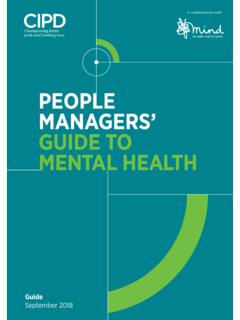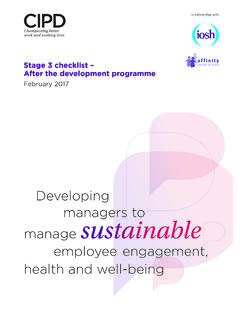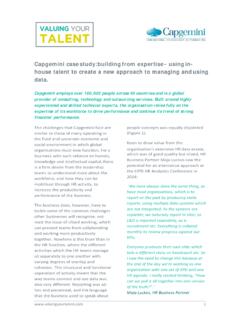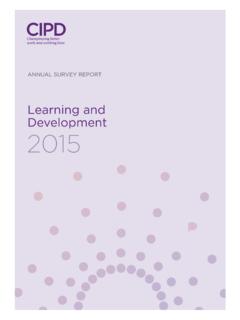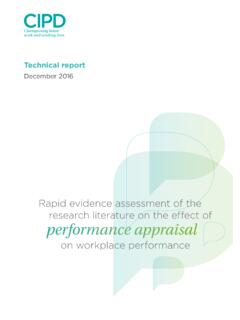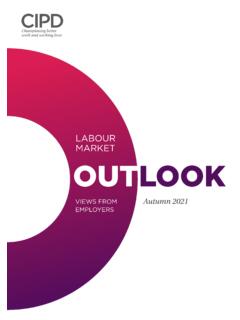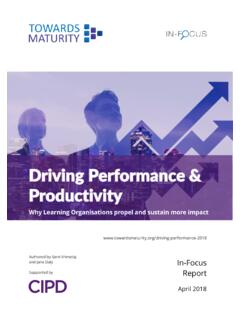Transcription of DEVELOPING THE NEXT GENERATION - CIPD
1 Learningto WorkTODAY S YOUNG PEOPLE, TOMORROW S WORKFORCER esearch report June 2015 DEVELOPING THE next GENERATION1 DEVELOPING the next generationThe CIPD is the professional body for HR and people development. The not-for-profit organisation champions better work and working lives and has been setting the benchmark for excellence in people and organisation development for more than 100 years. It has more than 135,000 members across the world, provides thought leadership through independent research on the world of work, and offers professional training and accreditation for those working in HR and learning and DEVELOPING the next generationDeveloping the next generationResearch reportContentsForeword 2 Introduction 31 What does existing research tell us?
2 62 Building the business case for investing in development 93 Workplace skills 144 Development methods 195 Generational learning preferences 23 Conclusion 27 References 28 AcknowledgementsThis report was written by Ruth Stuart, Research Adviser at the CIPD. The research was supported by Katerina R diger, Katherine Garrett and Stella Martorana at the CIPD. We are indebted to all of the individuals in the case study organisations who took part in the research through interviews and focus particular we would like to thank:Temi Akinmoladun Apprentice, BarclaysShajjad Ali Apprentice, ActionAidSarah Bampton Talent Programme Manager, FujitsuJoe Calvert Apprentice, BarclaysDemi Cameron-Smith Apprentice, FujitsuMike Hill Community Leader, BarclaysThomas McCumiskey Apprentice, CapgeminiOsmond McNellie Apprentice, BarclaysJames Millar Apprentice, CapgeminiRebecca Plant Head of Graduate and Apprentice Programmes, CapgeminiGraham Salisbury Head of Human Resources, ActionAidSusithaa Sathiyamoorthy Apprentice, ActionAidDan Snowdon Industrial placement, FujitsuNigel Spencer Global Director of Learning & Development, Reed SmithIrha Syed Apprentice, BarclaysClaire Theijssen Graduate, FujitsuMike Thompson Director, Early Careers, BarclaysDylan Valentine Apprentice graduate, FujitsuPhilip Wampamba Apprentice, ActionAidNick White Graduate Programme Manager.
3 Fujitsu2 DEVELOPING the next generation3 DEVELOPING the next generationForewordTackling youth unemployment is now recognised as a major issue by policy-makers, charities and many employers. It is clear that too many young people are being overlooked for opportunities, despite businesses concerns about where their future talent is coming from. Employers play a central role when it comes to improving young people s access to the labour market, and it is vital that organisations bring in young people if they are to build the skills they need for future success. Getting employers involved in helping to prepare young people for work and making their own organisations more youth friendly is something the CIPD has been leading on since we launched our Learning to Work programme back in 2012. Over the past three years we have seen an increase in the number of employers who are interested in increasing engagement with young people, including by offering more access routes into their organisations, such as Apprenticeships and graduate , offering and recruiting for these roles is only one half of the equation.
4 It is also crucial that when a young worker begins their career, the experience sets them up for a long and successful working future. Line managers have a crucial role to play here, a topic we covered in our Managing Future Talent guide. But, also fundamental to ensuring future success are the programmes themselves, their content, structure and how they are integrated into the wider business. Here is where the role of the HR and learning and development (L&D) practitioner is key and why we have drawn on best practice case studies of the programmes used to develop young people in more detail in this latest research report. The research is designed to help anyone working on, or considering introducing, their own programme. A recurring challenge for those seeking to bring in young people into their organisation is often establishing the business case, which is why when we originally launched the Learning to Work programme we explored this in some detail and why we look at this further in this latest report.
5 It is no good introducing a new programme for young people without first considering the wider business case and ensuring it fits in with future resourcing needs. For many, including Barclays and Capgemini, who both feature in this report, it is about attracting and retaining non-graduate talent, providing an attractive alternative to university while also plugging skills gaps. In recent years we have seen substantial debate around the topic of skills gaps, with the education sector, and even young people themselves, facing public criticism for not DEVELOPING the right skills needed in the workplace. The role of the employer in plugging these gaps has been disputed by some but we know the tide is changing, with skills development playing a central role in the design of many programmes targeted at young people. However, it s important that employers do not oversimplify the younger GENERATION when they design and implement a new programme.
6 There are many prevailing myths and generalisations about what the youngest GENERATION is like, such as they are more networked, less competitive and less loyal, meaning they more likely to move between organisations. Exploring the differences between the key broad generational groups estimated to represent today s workforce was a key starting point for this research, as it helps to bust these myths and provides a useful starting point for HR and L&D professionals exploring the needs of young people in their organisation. While it is important to avoid generalisations, gaining an appreciation for some of the key strengths and development areas for the younger GENERATION can help to ensure that programmes are designed in a way that gets the most from young talent. Organisations such as fujitsu and ActionAid, for example, share how they are taking advantage of the energy and enthusiasm that their apprentices have.
7 Implementing well-thought-out programmes that both draw out strengths and address weaknesses is key to getting the development of the younger GENERATION right. These individuals have enormous potential to contribute to an organisation s success and it s important that as a profession we recognise this and play our part in making this happen. Katerina R digerHead of Volunteering and Employability CampaignsCIPD3 DEVELOPING the next generationIntroductionBackground to the researchDuring the last few years we have seen a widespread recognition of the challenge of youth unemployment, and a corresponding rise in alternative entry-level development programmes such as innovative graduate schemes, new apprenticeships and work-based degrees. Through our Learning to Work programme we have worked with young people and organisations to promote and drive good practice, highlighting the benefits of broadening access to work and the importance of employer this report we turn to consider what happens in the workplace post-recruitment.
8 We explore methods of DEVELOPING 16 24- year -olds in the workplace, and identify what works and why; which skills do young people enter the workplace with and what s the most effective way of building their capability? We also consider learning preferences of young people, and how these align to interpretations of GENERATION Y purpose is to help organisations understand how they can build the business case, not just for broadening access to employment, but for investment in development to drive organisational performance. It is relevant for anyone working in HR, L&D or a line management role seeking to understand how they can best meet the development needs of the next GENERATION . Throughout the report we refer to what leading organisations in this space are doing, and the challenges they are overcoming, so that others can learn from examples of great practice. The findings build on our guide for line managers, Managing Future Talent (Peate and Taylor 2014).
9 We also connect the research to wider changes in the L&D profession (which we explore in Stuart and Overton 2015) and share the implications for HR and L&D practitioners. Learning to WorkThe Learning to Work programme is led by the CIPD to promote the role of employers in reducing youth unemployment. The CIPD s purpose is to champion better work and working lives, which starts with young people being able to access the labour overall aim of the programme is to promote the business case for investing in the future workforce. We encourage HR professionals to offer a wide range of access routes into their organisations and ensure their recruitment and management practices are youth-friendly. We also promote direct contact with young people via two youth volunteering programmes, Steps Ahead Mentoring and Inspiring the Future. We explore methods of DEVELOPING 16 24- year -olds in the workplace, and identify what works and why.
10 4 DEVELOPING the next generation5 DEVELOPING the next generationOverview of programmes for young people Only a few years ago the graduate programme was typically the main source of structured entry-level development for young people. But this is now changing. Seventy-six per cent of HR professionals report that their organisation offers at least one programme aimed at young people (CIPD 2015). Many of these programmes help to broaden access, through schemes such as apprenticeships, work-based degrees and industrial placements (Table 1). And others have sought to evolve their existing graduate programmes to ensure they meet both business and learner needs. Research methodologyThe research was conducted between January and February 2015 with five case study organisations (Table 2). Interviews were held with senior HR and L&D professionals. Focus groups and interviews were also held with young people currently on graduate programmes, industrial placements or apprenticeships.

